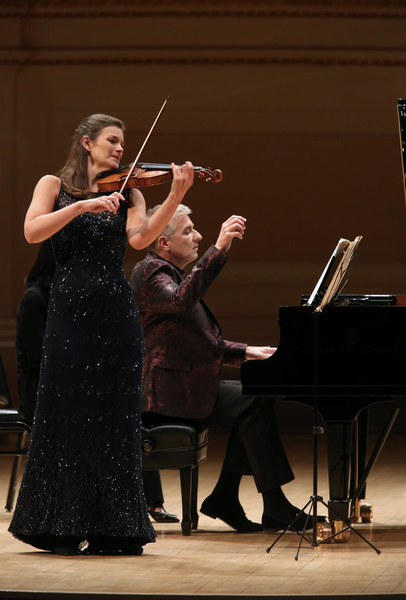Jansen and friends bring romantic spirit to Carnegie program

Janine Jansen performed with Jean-Yves Thibaudet in her “Perspectives ” program Sunday at Carnegie Hall. Photo: Steve J. Sherman
One of Carnegie Hall’s signature projects is the “Perspectives” series, a chance for guest artists to curate multiple concerts, according to no rules but their own. Often this means a chance to hear a performer advocating for works of personal interest, that might not otherwise be heard. That was very much the case with Janine Jansen’s penultimate “Perspectives” concert this season, as she was joined for a Sunday matinee of Romantic chamber music by piano star Jean-Yves Thibaudet and the talented young Dover String Quartet.
The most celebrated piece on the program was the opener, Debussy’s Violin Sonata, and the performance given by Jansen and Thibaudet was just about ideal. A brilliant array of colors was on display right from the start of the opening Allegro Vivo. The glassy sound so associated with musical impressionism was certainly in evidence, but Jansen balanced it well with smoky richness and delicious portamentos on the lower strings. Jansen is a rhapsodic player—she takes a free-ranging approach to the music, but the purpose of her choices is always clear. Thibaudet, no surprise, was expert in creating rippling textures, and just as convincing in broader, more aggressive material.
The second movement, “Intermède,” was a playful contest between tripping excitement and pensive calm. In the thrilling Finale, Jansen showed off her instrument’s full range, while Thibaudet showed a superb contrast between the murky sounds at the bottom of the keyboard and glittering brightness at the top.
The first half of the program was rounded out by Grieg’s Violin Sonata No. 2 in G Major, a more straightforwardly Romantic piece than the Debussy. Both players exhibited a sense of fun in their music-making, using excited, hushed moments to set up bursts of joy. The Allegretto tranquillo, its marking aside, was bracing, and the last movement showed capricious, fast-flying whimsy. In a performance like this one, there is no question that Jansen has the soul of a Romantic violinist: there is a wild spirit to her playing to which she is never afraid to give free rein.
The afternoon closed with Ernest Chausson’s Concert for Violin, Piano, and String Quartet. It’s odd to think that this intriguing piece was written as early as 1889: its open sonorities and unresolved dissonances feel like they come from the heady transition of late Romanticism into modernism. The first movement, based on a three-note open chord, showed tight ensemble from the Dover Quartet, and gutsy work by Jansen, playing deep into the string.
Lovely pulses and flowing tenderness characterized the Sicilienne, moving into the devastating emptiness of the Grave. Here, a somber, simple melody in the violin opens over essentially a one-voice piano accompaniment with a chilling pedal tone. The quartet mostly serves as accompaniment, yet the rich textures created by Dover were essential to the overall composition of the piece. The initial simplicity of this movement grew eventually into intense melancholy, a hair-tearing kind of sorrow, for the most gripping playing of the afternoon.
The finale featured nimble, bright playing by Thibaudet, accompanied by enormous sound from the combined strings. Dover ably handled the quick relays of their rapidly twisting accompaniment. The combination of virtuosity and attentive, sensitive chamber playing exhibited by all six performers on Sunday was a rare and wonderful thing.






